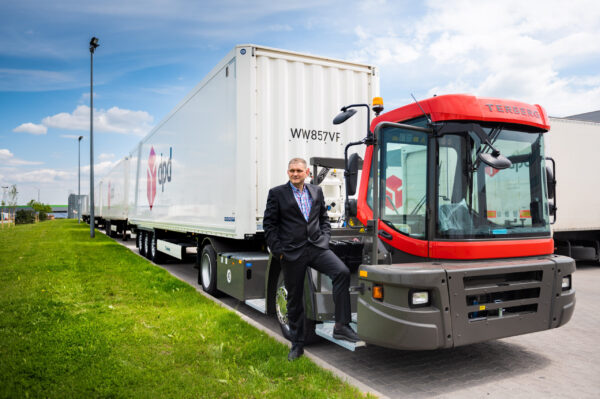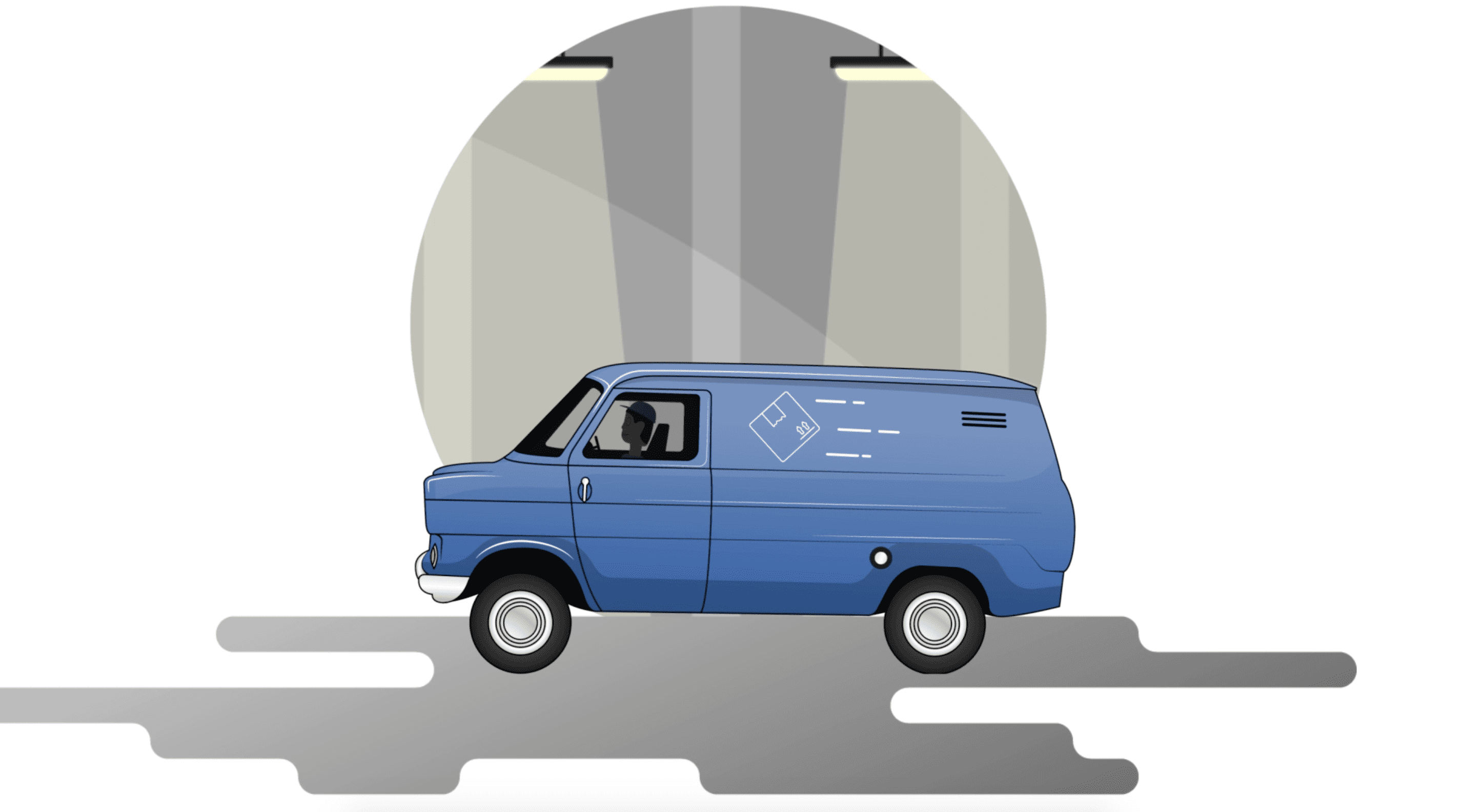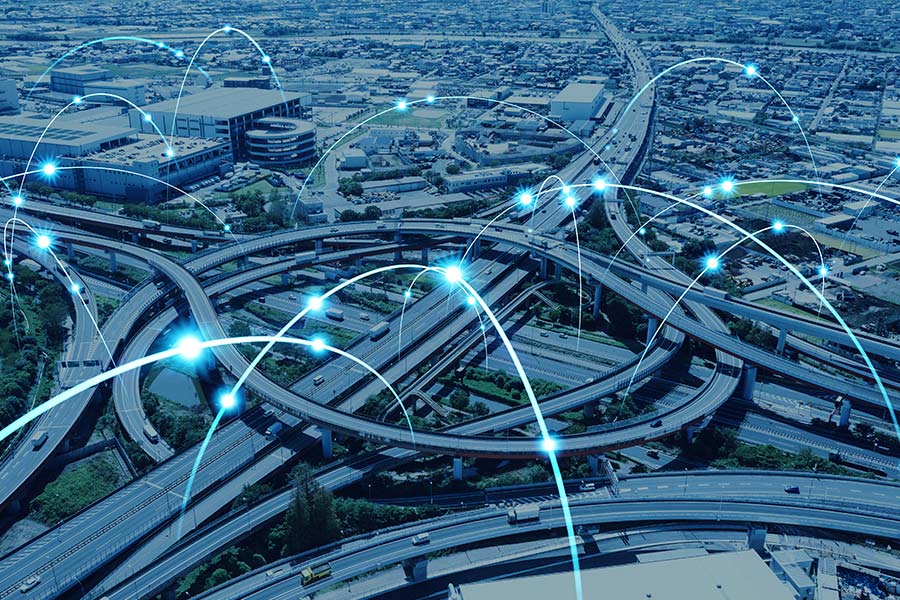We talk to Marcin Michalak, Director of Network Management at DPD Poland, about the impact of the COVID-19 pandemic on the operations of courier companies, the challenges of managing one of the largest transport networks in Poland, as well as the course of implementation and the business effects of using a TMS class system provided by Omecon.

This material is an interview that appeared in the June issue of ITwiz magazine.
With our scale of operations, it would be more difficult without the new TMS
How much has the courier services industry changed with the advent of the COVID-19 pandemic?
During the pandemic, the role of couriers increased significantly and they became the main intermediaries in current trade flows. Significant increases resulted from, among other things, increased e-commerce activity. Throughout 2020, we transported 193.5 million parcels. This is more than 24% higher than the year before, and in the first half of the year – mainly due to the restrictions introduced in March 2020 – increases reached up to 30%. We had 7,500 couriers working for us every day at peak times. Courier services have in many cases become the only possible distribution channel, which has translated into the scale of operations of express and parcel sector.
The specific nature of our business has also changed. Until now, the main peaks in network load were observed mainly at the turn of November and December. As a result of the pandemic, our regular load throughout the second quarter of 2020 remained at a level typical for December. This is a very big change, because if we are handling 700,000 parcels every day, a 30% increase suggests that 200,000 more parcels are coming into our network on a single day. Translating this into trucking, it means that we needed an extra 200 trucks overnight. Seasonality, which is a natural and constant part of the courier business, required us to be able to scale our processes. These skills – and technical capabilities – proved invaluable in the first weeks of the COVID-19 restrictions.
How much has the way DPD operates changed then?
Scaling up our operations in a short space of time was possible thanks to systematic investment in infrastructure development and the efficiency of individual branches. With reserve capacities at our disposal, we were able to increase the load on the infrastructure very quickly to ensure the required operational efficiency. In addition, we reorganised our business processes with a view to 24-hour operation.
In the area of the so-called last mile, on the other hand, we implemented a number of services and solutions that made it possible to complete the process of delivering consignments to recipients in a secure but formalised manner. I mean, for example, solutions facilitating contactless delivery and posting of shipments. Couriers have also been equipped with new, more convenient terminals supporting cashless payments.
Changes have also taken place in the area of truck transport. We introduced an electronic waybill and contactless truck clearance. Most of the team worked remotely, which required modifications to IT systems. This would not have been possible without a good and efficient TMS (Transport Management System), which allowed us to increase the scale of operations easily and quickly.
“Thanks to the implementation of the new TMS system after the COVID-19 outbreak, we were able to introduce the electronic waybill functionality in a short period of time. Documents in a digital version, directly from the TMS solution, are transferred to the application for drivers, thanks to which the entire transport clearance takes place without contact. It seems to me that we were the first on the market to implement such a functionality. This was possible thanks to the extensive capabilities of the platform provided by Omecon. During the pandemic, we worked for several months at full capacity of the system 24 hours a day, 7 days a week, without major difficulties or downtime. During this time we also implemented new functionalities and solutions related to the pandemic in a fast and efficient manner. It is speed and efficiency that are of strategic importance here.”
How important is the business area of linehaul transport to you?
Transport department is the bloodstream of the logistics company. Timeliness and correctness of the flow of goods between branches depends on its efficiency, which is of key importance for the quality of the provided forwarding services. In turn, the heart of the transport department is the TMS system, thanks to which we can ensure the timeliness of collections and deliveries at individual branches in a planned and coordinated manner. The solution is also responsible for handling and effectively managing transport operations of loading and unloading trucks. Our network consists of almost 1,500 trucks and 2,500 trailers used on a daily basis, which illustrates the scale of transport operations in the company. Every month our hauliers cover approx. 12 million km, making us one of the largest transport networks in Poland. In the central sorting office of DPD Poland in Stryków on average 50 sets (semi-trailer and tractor) are handled per hour. Every stoppage in parcel handling operations as well as unloading and loading of trucks has its consequences. A quarter of an hour of delay translates into several thousand unsorted shipments and may even lead to difficulties in the surrounding traffic.
When and why did you start taking action to change the TMS system?
We conducted the first analyses with a view to selecting a new TMS class solution in 2017. This is because we were using a solution written specifically for DPD Polska a dozen years earlier, which did not guarantee sufficient scalability and flexibility. The functionality of that system no longer met our needs, and the performance did not meet the market and technical standards of the time. Even before the COVID-19 pandemic, we had seen a systematic increase in the scale of our operations. So we knew that at some point we would face the problem of insufficient system performance. We also lacked the ability to easily integrate the TMS with specialised solutions supporting our processes, including automation systems.
The desire to change the TMS system was also a result of company policy. We always try to act ahead of actual needs in order to guarantee the best possible customer service. We are focused on eliminating challenges before they actually occur. This approach paid off in March 2020. Our initial focus was on finding an off-the-shelf solution that would guarantee sufficiently high performance and availability. Flexibility was also important. Ultimately, it turned out that in view of the large scale of operations and the specific nature of the transport network, none of the available solutions met our expectations. It became necessary to implement a system tailored to our needs.
An important argument for choosing a solution tailored to us was the fact that in our organization the TMS class system is used on a rotational basis by several hundred people working in 60 branches and 3 sorting plants. We wanted the new solution to be modern but similar to the one used before. In this way, we wanted to avoid a revolution at the level of system operation.
In the end, you chose a solution built on Omecon’s &UP® platform…
The Omecon system provided us with was a new solution whose specification was adapted to our needs and enhanced with the functions we required. A number of factors influenced our choice. Firstly, the solution offered us the expected increase in productivity, as well as security and continuity of business operations.
Last but not least, we appreciated the architecture of the solution and its modular design, which enables relatively easy development of the system’s functionality and implementation of changes according to the new needs of our business. Thanks to the modular structure we can quickly respond to the market needs, and the wide possibilities of integration with other solutions supporting the transport area guarantee additional possibilities of process optimization.
“The TMS-class system built by the Omecon team is today the foundation of DPD Poland’s linehaul transport. It is fed with operational data from systems supporting retail transport operations. It is responsible for the distribution of timetables, generating confirmations of the performed operations, as well as transport orders and shipping documents, and the ongoing handling of parcel transport processes between our sorting centers and branches. It also supports carrier accounting and invoicing. Today it is difficult to imagine the functioning of our company without this solution.”
How do you recall the process of implementing the new TMS? Was the scale of your organisation a big hurdle?
Scale was only part of the challenge. The nature of the processes means that there are virtually no service windows in our business. As I mentioned, any interruption in transport service, and thus in the availability of the TMS solution, poses further challenges in this case. It was necessary to maintain full operational efficiency, therefore we divided the system implementation into two stages. The first one assumed using two solutions in parallel. We duplicated all operations in the existing system and in the tool provided by Omecon. The old solution remained the basis of our operations, while the new one played a supporting role. After stabilizing the new system and getting positive feedback from users, we reversed this arrangement. The new solution became the primary solution and the older one the secondary one. After verifying all operations, we switched off the old system. I think that the whole process – despite its complexity – went smoothly and without major surprises, which I owe largely to the Omecon team supporting us and the specialists from DPD Poland. The production launch of the solution took place in August 2020. All our assumptions about the functionality, performance or responsiveness of the manufacturer were met according to the assumed KPIs and SLA. Possible problems – natural in the case of this type of projects – were eliminated quickly and in a matter-of-fact manner.
Our operational efficiency was also affected by the ergonomics of working with the new solution and the additional functionality and integration possibilities. Having had the experience of working with the &UP system, we realise that in view of the changes associated with the COVID-19 pandemic and with such a scale of operations, if we had stayed with the old TMS system, our operational capabilities would have been limited.
“In terms of process efficiency, the ability to quickly integrate Omecon’s TMS solution with other specialist systems proved very useful. After its implementation, we were soon able to use the functionality of the so-called electronic seal, which was fully integrated with it. As a result, we have up-to-date information on the actual location of each of our trailers at all times. We can control the routes they take and any possible interference with the loading area.”
How has the implementation of the TMS solution provided by Omecon affected the efficiency of your company’s business processes?
Built by the Omecon team, the TMS class system has become the foundation of DPD Poland’s linehaul transport. It is fed with operational data from systems supporting retail transport operations. It is responsible for planning and distributing timetables, generating confirmations of the operations performed, as well as transport orders and shipping documents, and the ongoing handling of parcel transport processes between our sorting centers and branches. It also supports carrier accounting and invoicing.
In terms of process efficiency, the ability to quickly integrate Omecon’s TMS solution with other specialised systems proved very useful. After its implementation, we were soon able to use the functionality of the so-called electronic seal, which was fully integrated with it. As a result, we have up-to-date information on the actual location of each of our trailers at all times. We can control the routes they take and any possible interference with the loading area.
The implementation of the new TMS system at the beginning of the pandemic allowed us to quickly introduce the functionality of another supplier’s electronic consignment note. The digitalised documents go directly from the TMS solution into the driver application. As a result, the entire transport clearance takes place without contact. It seems to me that we were the first on the market to implement such a functionality.
What are your main plans in the area of upgrading systems to support the operation of the transport network?
In the area of transport network management, we are working, among other things, on greater use of automation of the most repetitive operations. We are focusing on unattended check-in processes, streamlining driver services, as well as digitisation of documents. We are aiming for a situation in which the driver of the regular transport lines of DPD Poland will independently enter the area of the transshipment site, check-in in the application, which will guide him to a specific position, but also indicate when to unload one trailer and download the next one. All information will be automatically downloaded from the system, and every step of the service will be verified. In collaboration with the Omecon team, we are also developing a TMS system. Among other things, we are in the process of creating interactive, self-service portals for our branches and hauliers.
“During the pandemic, the role of couriers increased significantly and they became the main intermediaries in current trade flows. Significant increases resulted from, among other things, increased e-commerce activity. Throughout 2020, we transported 193.5 million parcels. This is more than 24% higher than the year before, and in the first half of the year – mainly due to the restrictions introduced in March 2020 – increases reached up to 30%. We had 7,500 couriers working for us every day at peak times. Courier services have in many cases become the only possible distribution channel.”
The interview was conducted by Piotr Waszczuk.
Popular
Especially today, just as every other day, grateful for persistent struggling with time and adversities, appreciating invaluable role in creating stable logistics and supply chain and both building and developing Polish economy, we wish all Couriers ...
PwC, at the invitation from the Polish Transport and Logistics Employers’ Association Poland (Związek Pracodawców Transport i Logistyka Polska), has prepared a report aimed at summarizing the expected directions of development of the Polish road ...
A world where the ubiquitous technology has solved all current problems, a zero-growth world or a world without sufficient international cooperation. These are the scenarios for the future outlined in the new “Logistics 2040” report published by ...


